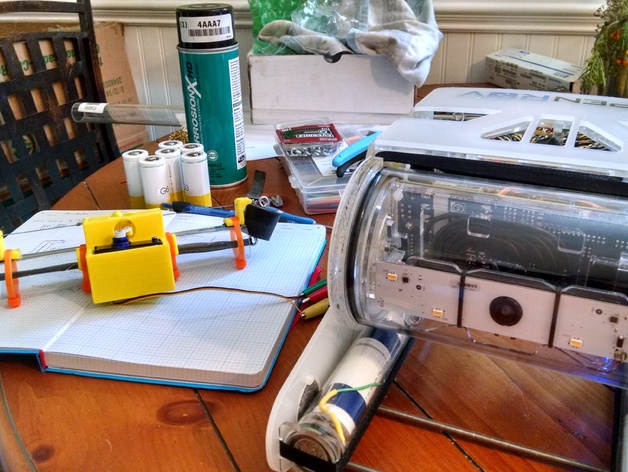
Niskin3D Water Sampler
thingiverse
The Niskin bottle, a remarkably straightforward tube designed to collect water samples at precise depths, is one of the most critical tools in oceanography. Paired with a CTD, an array of Niskin bottles provides everything and oceanographer needs to map the ocean's depths. This version is built around a 1.25 inch acrylic tube, the trigger mechanism can be easily expanded to fit any size pipe. The trigger is driven by a commercial waterproof servo (HiTec HS-646WP). Everything can be purchased off-the-shelf or printed on a home 3D printer. Watch a video of the device in action: 3D printable mini-Niskin bottle Read full build instructions at Oceanography for Everyone. Support more projects like this by contributing to my Patreon: Tools for ocean science and conservation 5/20/2016: The original receiver file was bad. The file has now been updated. Project: Niskin3D Project Name Niskin3D: a 3D-printable water quality sampler for marine science and conservation projects. Overview & Background The Niskin bottle is one of the most essential tools for studying oceans and large lakes. It allows researchers to collect water samples at specific, discrete depths, which, when combined with a CTD, can produce a comprehensive water column profile. This open-source Niskin bottle is triggered by a small waterproof servo and can be cast by hand line or carried as a payload on an OpenROV, Seaperch, or other underwater robotic platform. Objectives In addition to developing 3D printing skills, students will learn the basics of water quality monitoring and marine and freshwater oceanography. Depending on which platforms the instructor decides to use, students will also learn about servos, waterproofing electronics, basic Arduino programming, and integrating devices with robotic systems. Audiences Grade 8 through 12. Undergraduate environmental science majors. Subjects Marine Science Environmental Science Ecology Engineering Electronics Chemistry Skills Learned (Standards) Programming Electronics Sample design and collection Lesson/Activity Introduction to Oceanography/Limnology: Discuss the basic features of oceans (or large lakes) and talk about why scientists would want to sample a water column at specific depths. Introduce other tools for basic oceanography, like the secchi disk, hand refractometer, CTD, or other available tools. Water Chemistry: Teach students about pH and how to measure it using litmus paper or a pH meter. Demonstrate changes in pH using a simple system to acidify water, like a SodaStream CO2 injector. Discuss why dissolving CO2 in water would increase the acidity. 3D printing/fabrication: Students will print the Niskin3D parts on a 3D printer, cut tubes to length, prepare rubber stoppers, bands, and servos, and assemble the units. If using a handcast and manual system, use the SparkFun servo guide. If integrating with an OpenROV, use the Niskin3D/OpenROV guide. Sample Design: Students will develop their own sampling regime to answer specific questions about their local waterways. Some useful questions to start with: Is the pH of a lake/pond/stream higher at the surface than at the bottom? Is the salinity of the harbor different at high tide than low tide? Does the salinity of an estuary change with depth? Field experiment: Students will take their tools out into the field and implement their sampling design. Write-up and report: Students will write up their project in the form of a scientific paper and present their results to the class. Duration Minimum of 1 week. Depending on availability of resources and depth of research projects, could be a semester-long project. Preparation Students should prepare by reading the below handouts. Instructors should prepare lessons in oceanography and water chemistry, with appropriate demonstrations. References Oceanography for EveryoneOceanography for Everyone GitHub RepoNiskin3D project page and bill of materials Rubric & Assessment Student projects should be graded based on effort and completion. Focus should be on the process, with an emphasis on the fact that real scientific experiments don't always work and that grading is not dependent on getting the "right" result. Final papers and presentations should be graded in accordance with the school/universities standards. Handouts & Assets Sparkfun Servo Trigger Hookup GuideThe Common Oceanographer: Crowdsourcing the Collection of Oceanographic DataMeasuring the Sea: Do-It-Yourself Oceanographic Equipment
With this file you will be able to print Niskin3D Water Sampler with your 3D printer. Click on the button and save the file on your computer to work, edit or customize your design. You can also find more 3D designs for printers on Niskin3D Water Sampler.
